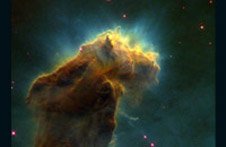
Lately, I’ve been going to the temple weekly to get the ordinance work done for a large number of names my mother has gathered in her ongoing genealogical research. This frequency of attending has given me many opportunities to ponder the creation story. At the same time, I’m a science geek and writer of hard sci-fi. The evidence scientists have observed about the origins of the universe is something I’m particularly interested in, especially as it relates to the Earth’s origins.
It’s axiomatic to say the aims of science and religion are the same, the pursuit of truth. Though science tends to be driven by doubt and religion by faith, they both move forward by asking questions. My expectation is that as we come to know the truth of things, we’ll see they both say the same thing… just from different paradigms. From where I sit, science answers and fills in the “what” while religion answers the “why.”
I think that can be seen in the origins of the universe and the Earth. This series of blog posts will examine this “convergence” of science and religion on that one topic. I’d love to have you come along and give your comments as we go. We’ll take the creation story day bay day. So, here’s the first day:
In the beginning God created the heaven and the earth. And the earth was without form, and void; and darkness was upon the face of the deep. And the Spirit of God moved upon the face of the waters. (Genesis 1:1-2)
The creation stories available to us all tell the same story with just a few variations. They have a common thread in that they are told as if being recounted by an observer who stood upon the Earth’s surface watching things occur. In this blog, I’ll recount the events from a vantage point in space, near the Earth.
While I believe there are the creative periods, I disagree with the interpretation that each one denotes a literal day. A more figurative approach fits events better: a creative period is just that, a phase in a process that takes a very long time to occur. From the perspective of a being who is eternal, whether that’s a day, a thousand years, or a billion, it’s still a period of time that, in the grand scheme of things, is not that long. After all God is, if nothing else, patient: if you want proof consider that He puts up with all of us.
Before the earth formed, it existed as part of a cloud of gas comprised of hydrogen, helium, lighter elements, and a scattering of heavier elements that were the debris from a near by supernova. How better to describe it than being without form? At the big bang, it started out as a mass of sub-atomic particles too energetic and hot to form into even protons. Then the entire cosmos as we know it was too hot to be anything but an opaque fog of super-heated sub-atomic particles. Surely that’s without form and void too!
As the universe expanded, it cooled enough for protons and other basic particles to form, not a lot, since just five percent of the mass of the universe coalesced into particles we understand as matter, but it was enough. The first stars formed. These behemoths were formed almost entirely of hydrogen and helium and most likely died as fantastic supernovae scattering heavier elements throughout the universe and galaxy. It would take another generation of stars born of the remnants of these early stars to form and explode as supernovae before there were enough heavier elements for life as we know to form.
And so it happened. Maybe it was God using the ripple of a gravity wave cause by an exploding star that started it, but our solar system began to form. The sun first and then Jupiter and then a set of hot Jupiters close into the sun. No earth yet. Because of the density of the gas, it acted as a brake, slowing Jupiter and causing it to spiral in towards the sun. As it did, it gravitationally interacted with these other inner planets either ejecting them from the solar system, breaking them apart or throwing them into the sun. We’re not sure, but somewhere during this process, Saturn formed and it began an intricate dance with Jupiter which eventually led to it and Jupiter being flung away from the sun into their current orbits.
In the process though, Jupiter had swept the inner system of most of the gas that was there, but gravity being gravity and Heavenly Father being who He is, several small planets formed from what remained. In all likelihood, when the Earth first formed, it had an opaque gaseous envelope, much like Neptune but with a rocky core buried under many hundreds of miles of hydrogen and helium.
At this point, we reenter the Biblical narrative. Standing on the surface of the Earth, it was a dark place devoid of life and barren, which also fits the Genesis narrative. There may have been surface water or it may have been held in the thick atmosphere surrounding the planet, we’re not sure, but in either case it was a dark, hot, desolate place.
And God said, ‘Let there be light.’ And God saw the light, that it was good: and God divided the light from the darkness. (Genesis 1: 3-4)
Science isn’t sure on what happened next to cause the atmosphere to boil away. Some argue it started out thin, but the biblical narrative says otherwise. The theories which agree with the Bible indicate radiation from a near by supernova or large star or instabilities in the sun’s output as it contracted and ignited may have led to the earth’s atmosphere boiling away. Regardless of the source, it was light and radiation which played the next part in the Earth’s formation… stay tuned.
Links: